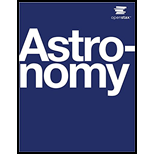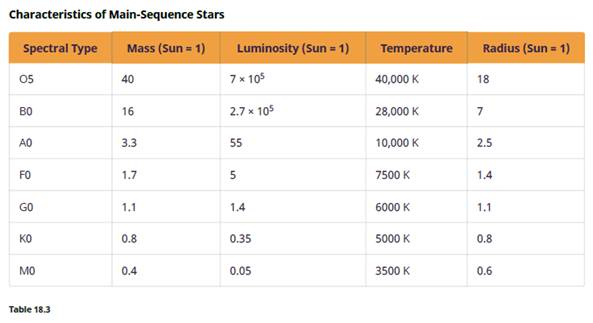
Astronomy
1st Edition
ISBN: 9781938168284
Author: Andrew Fraknoi; David Morrison; Sidney C. Wolff
Publisher: OpenStax
expand_more
expand_more
format_list_bulleted
Concept explainers
Textbook Question
Chapter 18, Problem 25E
Use the data in Appendix J to plot an H−R diagram for the brightest stars. Use the data from Table 18.3 to show where the main sequence lies. Do 90% of the brightest stars lie on or near the main sequence? Explain why or why not.

Expert Solution & Answer
Want to see the full answer?
Check out a sample textbook solution
Students have asked these similar questions
The cylindrical beam of a 12.7-mW laser is 0.920 cm in diameter. What is the rms value of the electric field?
V/m
Consider a rubber rod that has been rubbed with fur to give the rod a net negative charge, and a glass rod that has been rubbed with silk to give it a net positive charge. After being charged by contact by the fur and silk...?
a. Both rods have less mass
b. the rubber rod has more mass and the glass rod has less mass
c. both rods have more mass
d. the masses of both rods are unchanged
e. the rubber rod has less mass and the glass rod has mroe mass
8) 9)
Chapter 18 Solutions
Astronomy
Ch. 18 - How does the mass of the Sun compare with that of...Ch. 18 - Name and describe the three types of binary...Ch. 18 - Describe two ways of determining the diameter of a...Ch. 18 - What are the largest- and smallest-known values of...Ch. 18 - You are able to take spectra of both stars in an...Ch. 18 - Sketch an HR diagram. Label the axes. Show where...Ch. 18 - Describe what a typical star in the Galaxy would...Ch. 18 - How do we distinguish stars from brown dwarfs? How...Ch. 18 - Describe how the mass, luminosity, surface...Ch. 18 - One method to measure the diameter of a star is to...
Ch. 18 - We discussed in the chapter that about half of...Ch. 18 - Is the Sun an average star? Why or why not?Ch. 18 - Suppose you want to determine the average...Ch. 18 - Why do most known visual binaries have relatively...Ch. 18 - Figure 18.11 shows the light curve of a...Ch. 18 - There are fewer eclipsing binaries than...Ch. 18 - Within 50 light-years of the Sun, visual binaries...Ch. 18 - Which is easier to observe at large distances-a...Ch. 18 - The eclipsing binary Algol drops from maximum to...Ch. 18 - Review this spectral data for five stars. Which is...Ch. 18 - Which changes by the largest factor along the main...Ch. 18 - Suppose you want to search for brown dwarfs using...Ch. 18 - An astronomer discovers a type-M star with a large...Ch. 18 - Approximately 6000 stars are bright enough to be...Ch. 18 - Use the data in Appendix J to plot an HR diagram...Ch. 18 - Use the diagram you have drawn for Exercise 18.25...Ch. 18 - Use the data in Appendix I to plot an HR diagram...Ch. 18 - If a visual binary system were to have two...Ch. 18 - Two stars are in a visual binary star system that...Ch. 18 - Describe the spectra for a spectroscopic binary...Ch. 18 - Figure 18.7 shows the velocity of two stars in a...Ch. 18 - You go out stargazing one night, and someone asks...Ch. 18 - If you were to compare three stars with the same...Ch. 18 - Are supergiant stars also extremely massive?...Ch. 18 - Consider the following data on four stars: Which...Ch. 18 - If two stars are in a binary system with a...Ch. 18 - It is possible that stars as much as 200 times the...Ch. 18 - The lowest mass for a true star is 1/12 the mass...Ch. 18 - Spectral types are an indicator of temperature....Ch. 18 - We can estimate the masses of most of the stars in...Ch. 18 - In Diameters of Stars, the relative diameters of...Ch. 18 - Now calculate the radius of Sirius’ white dwarf...Ch. 18 - How does this radius of Sirius B compare with that...Ch. 18 - From the previous calculations and the results...Ch. 18 - How much would you weigh if you were suddenly...Ch. 18 - The star Betelgeuse has a temperature of 3400 K...Ch. 18 - Using the information provided in Table 18.1, what...Ch. 18 - Confirm that the angular diameter of the Sun of...Ch. 18 - An eclipsing binary star system is observed with...Ch. 18 - If a 100 solar mass star were to have a luminosity...Ch. 18 - If Betelgeuse had a mass that was 25 times that of...
Additional Science Textbook Solutions
Find more solutions based on key concepts
If all of Earths nitrogen-fixing prokaryotes were to die suddenly, what would happen to the concentration of ni...
Biology: Life on Earth with Physiology (11th Edition)
Consider the cross AaBbCCAABbCc. a. How many different gamete genotypes can each organ-ism produce? b. Use a Pu...
Genetic Analysis: An Integrated Approach (3rd Edition)
1. In uniform circular motion, which of the following are constant: speed, velocity, angular velocity, centripe...
Physics for Scientists and Engineers: A Strategic Approach, Vol. 1 (Chs 1-21) (4th Edition)
Which of the following has the greatest effect on the rate of chemical cycling in an ecosystem? (A) the rate of...
Campbell Biology (11th Edition)
Use a globe or map to determine, as accurately as possible, the latitude and longitude of Athens, Greece.
Applications and Investigations in Earth Science (9th Edition)
A mixed culture of Escherichia coli and Penicillium chrysogenum is inoculated onto the following culture media....
Microbiology: An Introduction
Knowledge Booster
Learn more about
Need a deep-dive on the concept behind this application? Look no further. Learn more about this topic, physics and related others by exploring similar questions and additional content below.Similar questions
- Lab 8 Part 3 PHET Wave Interface simulation. I am having trouble with this part of the lab.arrow_forwardMick and Rick are twins born on Earth in the year 2175. Rick grows up to be an Earth-bound robotics technician while Mick becomes an intergalactic astronaut. Mick leaves the Earth on his first space mission in the year 2200 and travels, according to his clock, for 10 years at a speed of 0.75c. Unfortunately, at this point in his journey, the structure of his ship undergoes mechanical breakdown and the ship explodes. How old is Rick when his brother dies?arrow_forwardHi, I have canceled, why did you charge me again?arrow_forward
arrow_back_ios
SEE MORE QUESTIONS
arrow_forward_ios
Recommended textbooks for you
 AstronomyPhysicsISBN:9781938168284Author:Andrew Fraknoi; David Morrison; Sidney C. WolffPublisher:OpenStax
AstronomyPhysicsISBN:9781938168284Author:Andrew Fraknoi; David Morrison; Sidney C. WolffPublisher:OpenStax Stars and Galaxies (MindTap Course List)PhysicsISBN:9781337399944Author:Michael A. SeedsPublisher:Cengage Learning
Stars and Galaxies (MindTap Course List)PhysicsISBN:9781337399944Author:Michael A. SeedsPublisher:Cengage Learning Foundations of Astronomy (MindTap Course List)PhysicsISBN:9781337399920Author:Michael A. Seeds, Dana BackmanPublisher:Cengage Learning
Foundations of Astronomy (MindTap Course List)PhysicsISBN:9781337399920Author:Michael A. Seeds, Dana BackmanPublisher:Cengage Learning
 Stars and GalaxiesPhysicsISBN:9781305120785Author:Michael A. Seeds, Dana BackmanPublisher:Cengage Learning
Stars and GalaxiesPhysicsISBN:9781305120785Author:Michael A. Seeds, Dana BackmanPublisher:Cengage Learning Horizons: Exploring the Universe (MindTap Course ...PhysicsISBN:9781305960961Author:Michael A. Seeds, Dana BackmanPublisher:Cengage Learning
Horizons: Exploring the Universe (MindTap Course ...PhysicsISBN:9781305960961Author:Michael A. Seeds, Dana BackmanPublisher:Cengage Learning

Astronomy
Physics
ISBN:9781938168284
Author:Andrew Fraknoi; David Morrison; Sidney C. Wolff
Publisher:OpenStax

Stars and Galaxies (MindTap Course List)
Physics
ISBN:9781337399944
Author:Michael A. Seeds
Publisher:Cengage Learning

Foundations of Astronomy (MindTap Course List)
Physics
ISBN:9781337399920
Author:Michael A. Seeds, Dana Backman
Publisher:Cengage Learning


Stars and Galaxies
Physics
ISBN:9781305120785
Author:Michael A. Seeds, Dana Backman
Publisher:Cengage Learning

Horizons: Exploring the Universe (MindTap Course ...
Physics
ISBN:9781305960961
Author:Michael A. Seeds, Dana Backman
Publisher:Cengage Learning